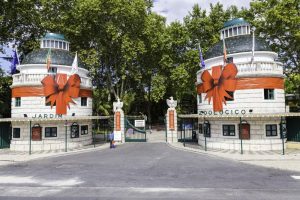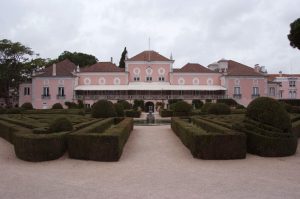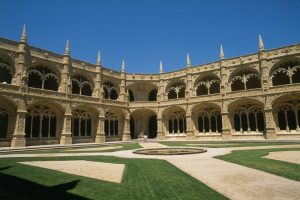Lisbon Zoo
Lisbon Zoo is one of the oldest zoos in Europe. Founded in 1884, it now has the largest zoological collection in the world: more than 2000 animals, reptiles and birds of more than 300 species, living in the most natural conditions possible.
Fado Museum in Lisbon
The Lisbon Fado Museum is particularly valuable for lovers of fado music, as well as for those interested in Portuguese culture and history.
Fado (derived from the Latin « fatum », which means « destiny ») is a particular style of traditional Portuguese music. It is a street romance, performed by a single performer accompanied by two guitars, a classical guitar and a Portuguese guitar (twelve-string guitar).
Basilica of Estrela in Lisbon
The Basilica of Estrela is one of the most impressive architectural monuments in Lisbon. It was built by Queen Mary I of Portugal, who promised to build a church if she had an heir to the throne.
Miradouro das Portas do Sol in Lisbon
Lisbon is one of the most beautiful cities in the world, located on seven hills. And thanks to this location, visitors can admire the city’s surroundings from many places. One of these points is the Miradouro das Portas do Sol, which is a few steps from another observation bridge, the Miradouro de Santa Lucia.
Puppet Museum in Lisbon
The Puppet Museum is the only and only museum of its kind in Portugal. It is located in a magnificent building, the former Bernardas monastery. The museum’s collection includes about four thousand pieces from more than 30 countries around the world.
Dona Maria II National Theatre in Lisbon
The historic building of the Dona Maria II National Theatre is located in Rossio Square, in the heart of Lisbon. The theatre building stands on the site of the former Palácio Dos Estaus, built around 1450 for foreign and visiting dignitaries in Lisbon.
Belém National Palace in Lisbon
The National Palace of Belém, built on a hill, is located in the Belém district, where there are many architectural monuments from the time of the great discoveries. The palace was the official residence of the Portuguese kings and the presidents of the Portuguese Republic.
Open Water Aqueduct in Lisbon
The Aguas Livres Aqueduct (literally « open water aqueduct ») is considered one of the most interesting structures in Lisbon. This impressively large construction is part of Lisbon’s water supply system and crosses the Alcantara Valley in northwest Lisbon.
Church of St. Roch in Lisbon Portugal
For more than 200 years, the church housed a Jesuit congregation until they were expelled from Portugal. After the earthquake in 1755, the church and outbuildings were handed over to the Mercy House in Lisbon (Santa Casa do Misericordia de Lisboa)
Monument to the Discoveries in Lisbon Portugal
The monument to discoveries is located in Belém, one of the main districts of Lisbon. The monument is not far from the Tagus, from where ships used to go on scientific and commercial expeditions to India and the East. The Lisbon Monument to Discovery glorifies the period of Portugal’s great geographical discoveries in the 15th and 16th centuries.
Portuguese National Hall of Fame in Lisbon
The Portuguese National Hall of Fame in Lisbon is one of the most beautiful architectural monuments in the Portuguese capital. This monument was called the National Pantheon in the 20th century, before it was the church of Santa Engrácia.
Lisbon Se Cathedral in Portugal
The cathedral building looks like a fortress. Two large massive belfries have loopholes for archery. The towers were also used as observation posts during wartime. The thick walls were completely devoid of windows in their lower parts, making Lisbon Cathedral invulnerable to enemy attacks.
São Bento Palace in Lisbon Portugal
Previously, there was a Benedictine monastery on the site of the San Bento Palace in Lisbon. At the beginning of the 17th century, the monks of this monastery founded a refuge for the sick and the poor. The new monastery began to be built at the beginning of the 18th century by the architect Balthazar Alvarez.
Visit Ericeira in Portugal
Ericeira is located on the west coast of Portugal, 35 km northeast of Lisbon. Ericeira is a popular destination for residents and tourists from all over the world. The climatic characteristics (high concentration of iodine), recreational and competitive surfing have made Ericeira popular.
The Church of Santo Antonio in Lisbon Portugal
Saint Anthony was born in Lisbon in 1195. According to legend, the church of Santo Antonio was built on the site of the house of Saint Anthony. The future saint, Fernando de Buljoins, was born into a noble and rich family. In 1229, while studying in Coimbra, he entered the Franciscan Order and took the name of Antonio.
Pedro IV column in Lisbon Portugal
The monument was erected in 1874 and the square became Pedro IV Square. But the square has regained its old name. Rossio Square has been one of Lisbon’s main squares since the Middle Ages. The modern name « Rossio » is a tribute to King Pedro IV of Portugal, who was also the first emperor of Brazil.
Pena Palace in Sintra, Portugal
The Palace of Pena in Sintra, which is said to be in Portuguese Palacio Nacional da Pena, is one of the most important tourist monuments in Sintra. The palace was built on the ruins of an old monastery under the direction of the German architect Baron von Eschwege. Since 1910, the palace has become a museum.
Jerónimos Monastery in Lisbon Portugal
At the beginning of the 16th century under Manuel I, the first stone of the monastery was laid and construction work began in 1517. The Jerónimos Monastery is one of the most remarkable Manueline style buildings in the world.
Arrabida Natural Park in Lisbon Portugal
Arrabida Natural Park is located on the northern bank of the mouth of the Sado River, between the town of Setubal and the fishing village of Sesimbra. The park was founded in 1976, covers an area of about 108 km2 and is one of 30 places in Portugal that are officially protected by the State.
Bridge of 25 April in Lisbon Portugal
The April 25 bridge in Lisbon, Portugal is very often compared to the Golden Gate Bridge in San Francisco (USA) because they have similar structures and colours (rope suspension bridge). It is interesting to note that this Lisbon bridge was built by the same company that built the San Francisco-Oakland Bridge (Bay Bridge), which also explains their similar design.
Castle of the Moors Sintra Portugal
The medieval castle of the Moors is located at the top of the Serra da Sintra mountain range and offers a breathtaking view of the municipality of Sintra, as well as Mafra and Ericeira. At the foot is a very beautiful park.
Boca do Inferno Cascais Portugal
Three kilometres from the city to the west, there is a cliff. It attracts the attention of many tourists because of a cave that was created by the waves. The cave is called Boca do Inferno, which means « the mouth of the devil ». This name was given to the cave because when the waves hit the rocks with great force, it creates an incredible roar and noise.
Sintra Cascais Natural Park in Portugal
The park extends near the Lisbon region along the Serra de Sintra mountain range, along the Atlantic Ocean coast, to Cabo do Roca (Cape Roca), which is considered the westernmost point in continental Europe. The park is located 25 km from Lisbon and is an extremely popular destination among tourists.
Vasco de Gamma Bridge Lisbon Portugal
The creation of the Vasco da Gama bridge has reduced traffic on the other Lisbon bridge: the 25 April bridge. It was for this specific purpose that Portugal began construction of the Vasco de Gama Bridge in 1995. Three years later in 1998, the bridge was opened for the 500th anniversary of the opening of the Vasco da Gama shipping route from Europe to India and the World Expo in Lisbon.
Ajuda National Palace in Lisbon, Portugal
The National Palace of Ajuda is a Lisbon museum used by the Portuguese government for official ceremonies.
Tróia Peninsula in Portugal
The Troia Peninsula is located in the municipality of Grandola, near the mouth of the Sado River.
Estoril Casino in Portugal
The Estoril Casino is located 15 km from the centre of Lisbon and has been a popular holiday destination for more than 40 years, not only for the local population but also for the inhabitants of Estoril. Estoril is a region and city in Portugal, located on the shores of Cascais Bay. The Estoril Casino is considered to be the largest casino in Europe.
Discover Fado in Lisbon
The musical genre of fado is as characteristic of Portugal as the waltz of Austria or the flamenco of Spain. A particular fado melody is recognizable from the first bars. It combines Moorish, African and Brazilian airs. The Portuguese name fado probably comes from the Latin Fatum: destiny. Fado singers often use the concept of saudade in their songs. A difficult word to translate to describe loneliness, melancholy, meaningless desire and anticipation of a sad future. As one of the songs says: « It exists, it’s sad, it’s fado ».
Visit Lisbon Oceanarium: the best aquarium in the world
Those who go for a walk in Lisbon cannot miss the opportunity to visit the Lisbon Oceanarium, which has a permanent exhibition and some temporary exhibitions. Do you want to meet him? Then come from there. Everything you need to know about visiting the Lisbon Oceanarium: exhibitions, schedules, tickets, access, activities and good reasons to visit…
Visit Cascais and Estoril
Cascais and Estoril are part of the so-called Lisbon Riviera. Two small towns along the ocean that practically fit into each other. The French Riviera of Lisbon is not a holiday destination in seaside resorts, but a seaside holiday destination. The ocean water, even in the hottest summer, does not exceed 18º C. It is a strange idea to come to Cascais to swim in the sea in summer, but coming to Cascais at any other time of the year just to breathe the air, walk along the ocean, admire the view of the coast and the old villas, is a great way to relax.
Visit Sintra
Sintra is the famous suburb of the Lisbon Palace. You will discover a beautiful natural landscape, the centre of a small Portuguese town, some royal palaces and charming parks, all surrounded by magnificent tropical vegetation. In general, a visit to Sintra is almost essential for any trip to Lisbon. In this article, I will try to answer the various questions you may have.
Visit the Pena Palace in Sintra
Château Pena is located in the charming suburbs of Lisbon – Sintra. The fairytale castle stands on the top of a high hill in the Sintra mountain range, not far from the city of the same name. On a clear day, the Palace of Pena is easily visible even from Lisbon and most of the large city. The Palace of Pena is a UNESCO World Heritage Site, a national monument of Portugal and one of the country’s seven wonders, along with Guimarães Castle, Obidos Castle, Batalha Monastery, Alcobaça Monastery, Jerónimos Monastery and Belem Tower.
Visit the Castle of Saint George in Lisbon
There is a certain charm in the São Jorge castle which is still hidden and mysterious. The view from the castle walls is really magnificent, from the hill you can see Lisbon from almost all sides, look into the small courtyards under the castle walls, touch very old stones. Despite all the tourist promotion of the castle, at the top of the hill you can feel an incomparable peace and tranquility.
































